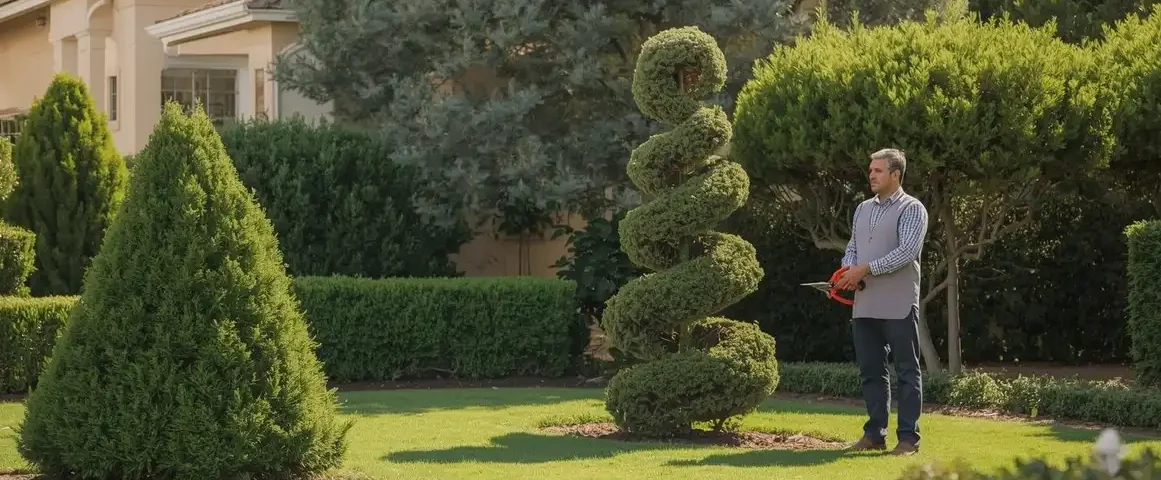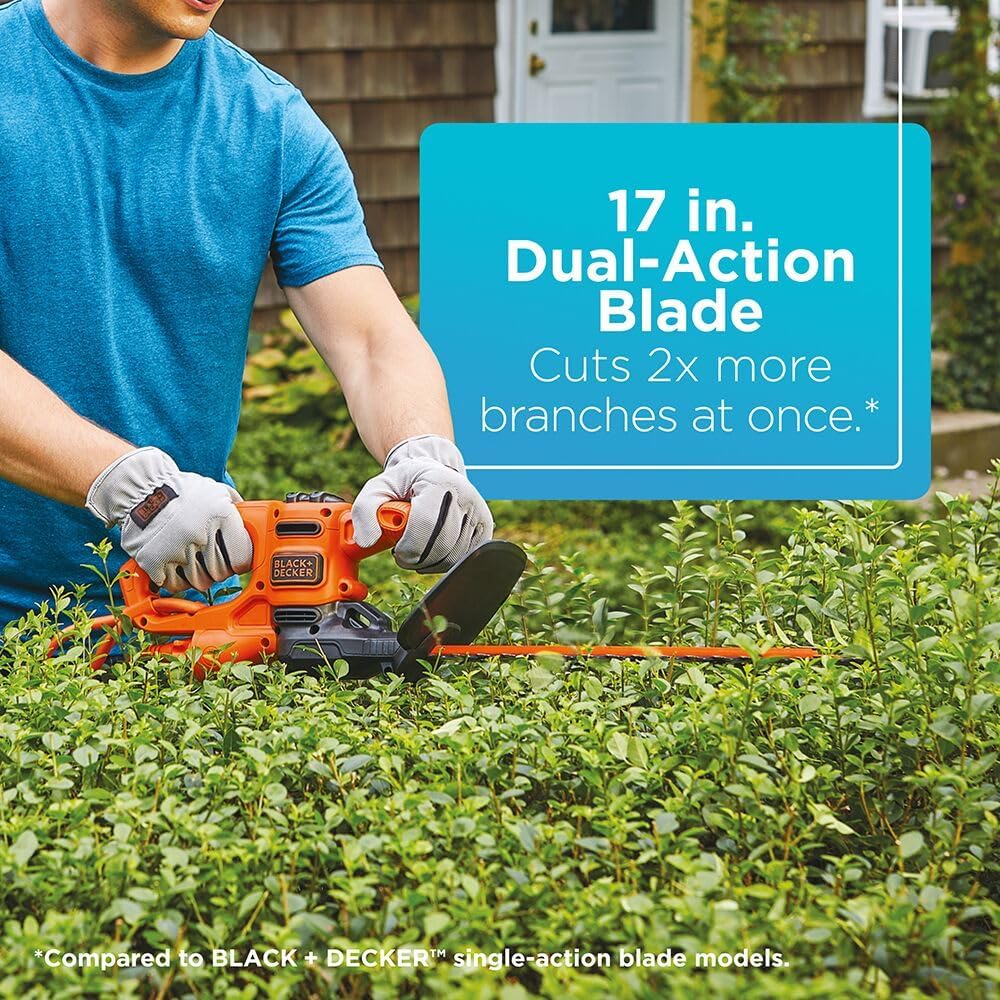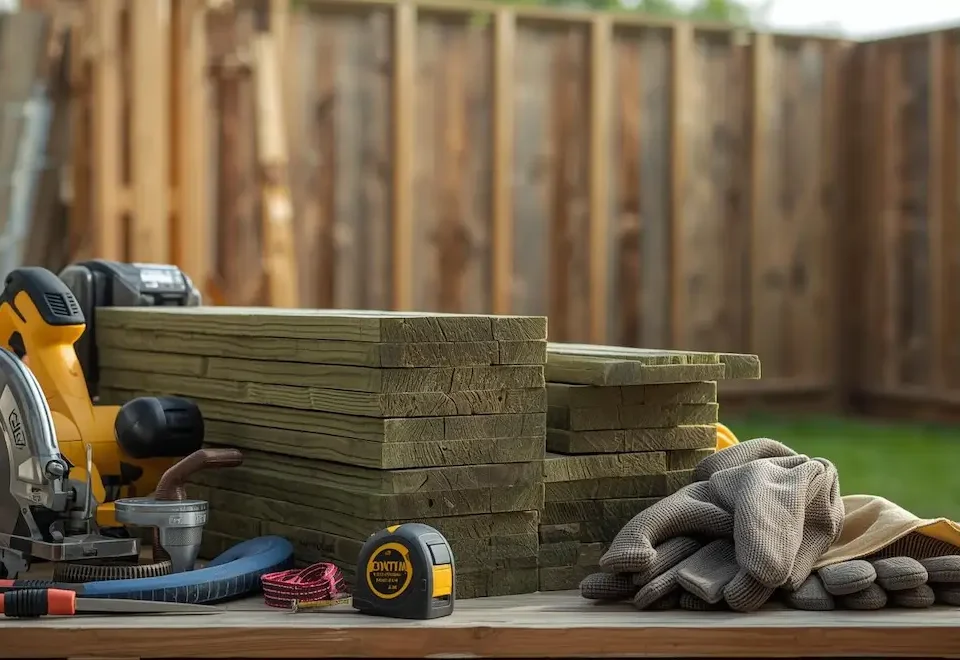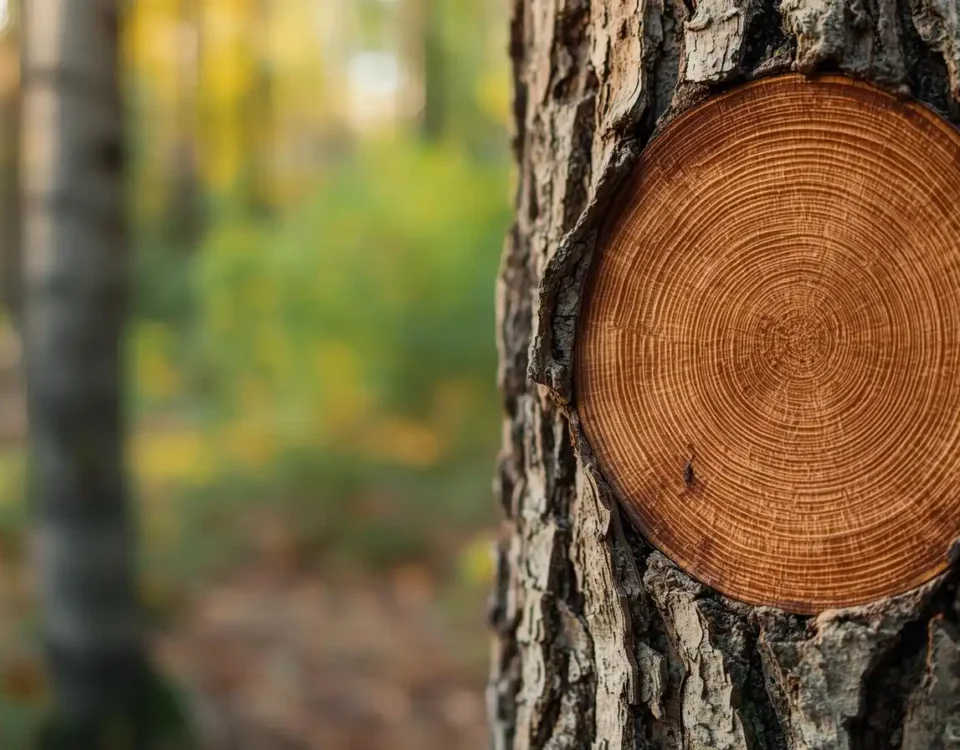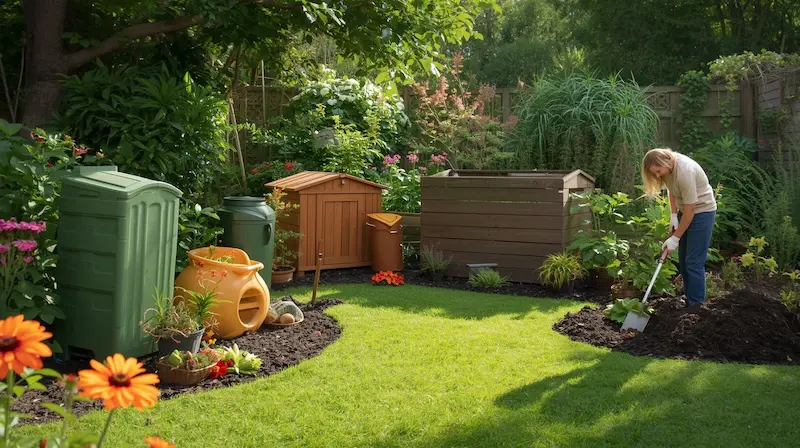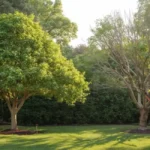
Stop Lion’s Tailing The DIY Guide to Healthy Tree Pruning for Strong, Beautiful Trees
October 27, 2025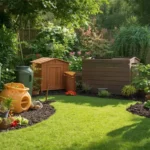
The 7 Best Outdoor Composters for Your Garden: A Comprehensive 2025 Buyer’s Guide
October 29, 2025Imagine standing in your garden, wishing for that perfectly manicured look with plants and mulch, but unsure where to start. Perhaps your trees feel wild and untamed, or you struggle to picture how shaping them could transform your outdoor space. Many homeowners dream of a landscape with elegant lines and clear focal points, yet the thought of pruning and sculpting can feel intimidating.
This guide is here to change that. We’ll take the mystery out of tree shaping and turn uncertainty into confidence. You’ll discover how selecting the right forms and maintaining them properly can elevate both the beauty and functionality of your property. By learning to sculpt your trees with intention, you can create a visually stunning and harmonious garden environment.
By understanding the unique characteristics of pyramid, lollipop, and vase-shaped trees, you’ll gain practical knowledge to choose the ideal forms for your landscape, prune them effectively, and ensure they thrive long-term. Get ready to turn your garden dreams, perhaps including a hugelkultur garden bed, into a reality filled with structure, style, and enduring beauty.
Basic Arboricultural Principles for Shaping
Understanding Natural Growth Habits
Every tree, part of a global forest count, has its own natural tendencies, and understanding these is key to shaping it successfully. Some trees grow with a central leader, forming a strong upright trunk, while others have spreading forms, creating wide, arching branches. Light, gravity, and environmental conditions all play a role in how a tree develops, influencing branch angles, density, and overall shape.
Expert Insight: Working with a tree’s natural growth patterns is far more effective than forcing it into an unnatural form. Trying to override these tendencies can stress the tree, reduce its longevity, and even compromise safety.
The Science of Pruning
Pruning isn’t just about aesthetics; it’s about health. When you cut a tree responds by healing the wound and producing new growth. Understanding this reaction helps you guide the tree’s development rather than causing unintended problems.
It’s also essential to distinguish between live wood, which can grow and heal, and deadwood, which should be removed for safety and visual appeal.
Pro Tip: Research your tree species thoroughly before pruning. Know its mature size, growth habits, and ideal pruning periods. Some trees resist certain forms, so patience and knowledge are key.
Key Pruning Terminology for DIYers
Learning the basics of arboricultural terms removes a lot of confusion for beginners:
- Branch collar: The swollen area at the base of a branch, crucial for proper pruning cuts.
- Bud union: Where the rootstock and scion meet, important for grafted trees.
- Scaffold branches: The main structural branches forming the tree’s framework.
- Thinning cuts vs. heading cuts: Thinning removes entire branches to open the canopy, while heading shortens branches to encourage dense growth. Knowing the difference ensures your pruning produces the desired effect.
Timing is Everything
Pruning at the right time of year maximizes benefits and minimizes stress. Major shaping is usually best done during dormancy, when the tree is less active, while maintenance pruning can occur during active growth to manage size and form.
To simplify planning, here’s a basic seasonal guide for shaping your trees:
- Winter (Dormant): Major structural pruning, removing dead or crossing branches.
- Spring (Early Growth): Light maintenance, encourage healthy new growth.
- Summer: Minor shaping and thinning, controlling size and canopy density.
- Fall: Avoid heavy pruning; focus only on safety cuts or deadwood removal.
The Pyramid Tree Shape: Characteristics & Applications
Defining the Pyramid Form
The pyramid tree shape is easily recognized by its broad base that tapers gradually to a pointed top, creating a strong vertical line. This form conveys a sense of formality, grandeur, and stability, making it a classic choice for structured landscapes. Its elegant silhouette can act as a natural anchor in your garden, drawing the eye upward and providing a striking visual presence.
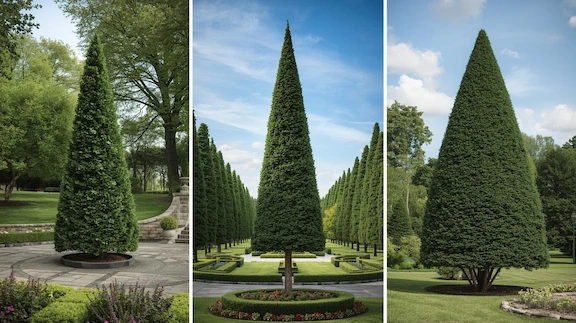
Ideal Landscape Uses
Pyramid-shaped trees are highly versatile in landscaping:
- Formal gardens: Their structured shape complements symmetrical designs and geometric layouts.
- Property borders and avenues: Planted in rows, they create rhythm, symmetry, and a sense of order.
- Focal points: A single pyramid tree can anchor a garden bed or highlight an entrance.
- Vertical interest & enclosure: Their upward growth draws attention and can provide subtle screening without overwhelming space.
Case Study Examples:
- Emerald Green Arborvitae along a driveway creates a narrow, elegant privacy screen while maintaining clean lines.
- Norway Spruce in a large formal garden serves as a grand vertical centerpiece, balancing flower beds and lawns.
Suitable Tree Species & Training Potential
Choosing the right species is essential to achieve the perfect pyramid form. Some trees naturally adopt this shape, while others can be trained with proper pruning techniques. Here’s a practical guide:
|
Tree Species |
Natural Pyramid Form? |
Ideal Climate/Zone |
Notes on Growth |
|
Norway Spruce |
Yes |
Zones 3-7 |
Dense, dark green foliage, classic conical shape. |
|
Emerald Green Arborvitae |
Yes |
Zones 3-7 |
Narrow, upright, excellent for privacy screens. |
|
Littleleaf Linden |
Can be trained |
Zones 3-7 |
Densely branched, adaptable to formal shaping. |
|
Sweetgum |
Yes |
Zones 5-9 |
Star-shaped leaves, vibrant fall color, strong structure. |
|
Bald Cypress |
Yes |
Zones 4-10 |
Deciduous conifer, feathery texture, adaptable to wet soils. |
Expert Tip: Always check your local climate and soil conditions before selecting a species. Even trees that naturally form pyramids may require some maintenance to thrive in a new environment. Local micro climates can affect various tree characteristics, including fast growth rates, foliage density, and overall shape.
The Lollipop Tree Shape (Standard Form/Topiary): Characteristics & Applications
Defining the Lollipop Form
The lollipop tree shape is defined by a clear, single trunk topped with a dense, rounded crown, resembling the classic candy on a stick. This form can feel whimsical and playful, yet it also lends a sense of structure and elegance when used in formal settings. Its clean lines make it easy to recognize and highly versatile in garden design.
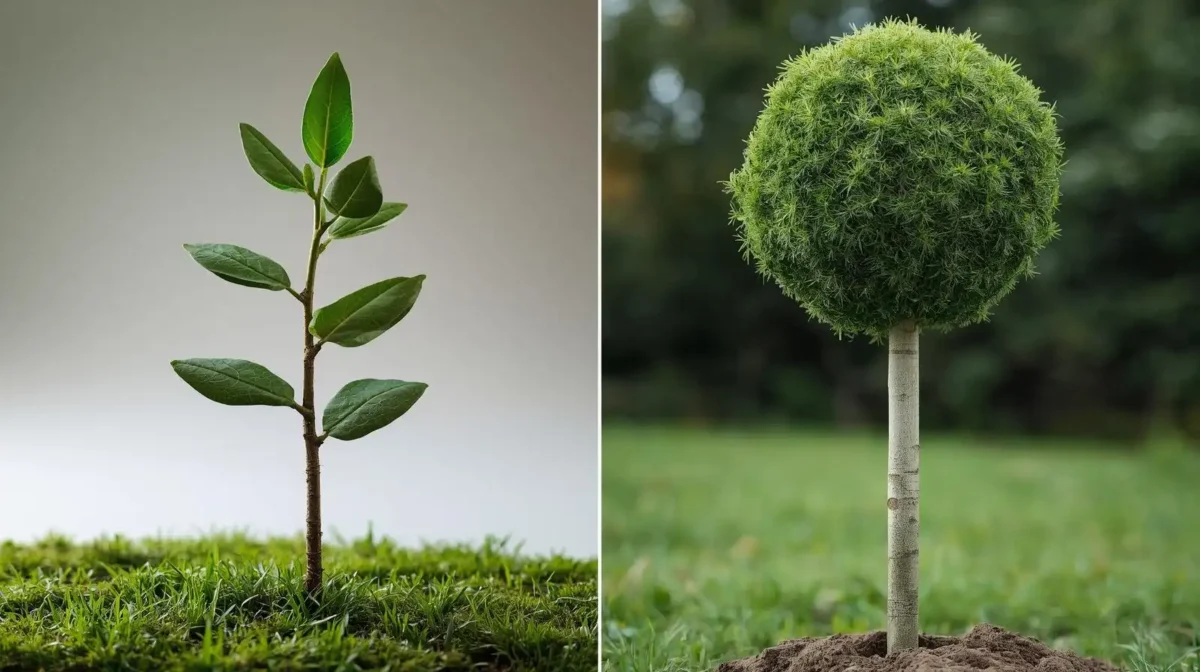
Ideal Landscape Uses
Lollipop trees excel in spaces where height is needed without excessive spread, making them perfect for:
- Containers and small gardens: Their compact form fits neatly into tight spaces.
- Formal entries or pathways: Repeating lollipop trees along a walkway creates a rhythmic, polished look.
- Underplanting opportunities: The clear trunk leaves room for flowers or low-growing shrubs underneath.
Beyond their practical use, lollipop trees evoke whimsy and can influence the psychological experience of a garden, adding a sense of charm, curiosity, and elegance to any space.
Suitable Tree Species & Training Potential
Creating a successful lollipop tree relies on selecting species that respond well to shaping and understanding their natural growth habits. Here’s a guide:
|
Tree Species |
Natural Growth Habit |
Maintenance Level |
Best For |
|
Weeping Cherry |
Weeping/Spreading |
Medium |
Ornamental focal point, small gardens. |
|
Crape Myrtle |
Multi-stemmed shrub |
Medium |
Summer color, warm climates, patio trees. |
|
Dwarf Alberta Spruce |
Conical |
Low |
Formal containers, entryways, and small spaces. |
|
Boxwood |
Shrubby |
High |
Formal topiary, intricate shapes. |
|
Privet |
Shrubby |
High |
Hedges, formal screening, classic topiary. |
Expert Tip: Start shaping early and gradually. Minor corrective cuts on young trees are far safer than drastic pruning on mature specimens, which can stress or even damage the tree. Also, pay attention to graft unions and rootstock when selecting specimens for training, especially in topiary forms.
The Vase Tree Shape (Open Center): Characteristics & Applications
Defining the Vase Form
The vase tree shape is characterized by an open center with strong, outward-spreading scaffold branches, creating a broad, airy canopy. This form isn’t just visually appealing; it also provides functional benefits. The open structure improves light penetration and air circulation, which helps prevent disease, encourages healthy growth, and promotes overall tree vigor.
Ideal Landscape Uses
Vase-shaped trees are especially suited to landscapes where light, space, and functionality are priorities:
- Fruit trees: The open center allows sunlight to reach all branches, improving flowering and fruit production.
- Large shade trees: Provide dappled shade while maintaining an airy, light-filled environment underneath.
- Understory planting: Their openness allows smaller plants to thrive below without being shaded out completely.
- Showcasing structural beauty: The elegant, spreading branches highlight a tree’s natural architecture.
By optimizing light and airflow, the vase shape not only enhances the garden’s aesthetic but also contributes significantly to the long-term health of the tree.
Suitable Tree Species & Training Potential
Certain trees naturally adopt a spreading, open form, while others can be trained into a vase shape for optimal health and function. Here’s a practical guide:
|
Tree Species |
Natural Branching |
Key Benefits of Vase Form |
Considerations |
|
Japanese Maple |
Spreading/Open |
Ornamental structural beauty |
Slow-growing, delicate branches. |
|
Dogwood |
Spreading/Layered |
Enhanced flowering, disease resistance |
Requires careful initial training. |
|
Elm (disease-resistant cultivars) |
Upright/Vase-like |
Excellent shade, classic form |
Rapid growth requires consistent pruning. |
|
Cherry (Prunus spp.) |
Spreading/Open |
Fruit production, air circulation |
Prone to some diseases, specific pruning times. |
|
Peach/Nectarine |
Open/Spreading |
Maximum fruit yield, sunlight exposure |
Annual heavy pruning is required for fruit quality. |
Expert Tip: For fruit trees, proper initial shaping is crucial. Early pruning establishes the vase form, maximizes fruiting potential, and reduces long-term maintenance. Always account for species-specific growth patterns and local climate when planning your tree’s shape.
Choosing the Right Tree Shape for Your Property: A Decision Guide
Assessing Your Property's Needs
Selecting the ideal tree shape starts with understanding your property and its goals. Many homeowners struggle with uncertainty about which shape best complements their space, but considering a few key factors can make the decision much clearer:
- Property size and scale: Large, open yards can accommodate pyramid and vase-shaped trees, while smaller gardens may benefit more from lollipop trees or container-friendly varieties.
- Existing landscape style: A formal garden aligns well with pyramids and topiary shapes, while informal or rustic gardens may suit vase-shaped or naturally spreading trees.
- Desired function: Determine if the tree is meant for shade, privacy, a focal point, or a windbreak, as this will influence both shape and placement.
Architectural style of your home: The tree should complement your house; angular, formal homes pair well with structured pyramids, while cottages or modern homes may benefit from softer, whimsical forms.
Imagine standing in your garden, wishing for that perfectly manicured look, but unsure where to start. Perhaps your trees feel wild and untamed, or you struggle to picture how shaping them could transform your outdoor space. Many homeowners dream of a landscape with elegant lines and clear focal points, yet the thought of pruning and sculpting can feel intimidating.
This guide is here to change that. We’ll take the mystery out of tree shaping and turn uncertainty into confidence. You’ll discover how selecting the right forms and maintaining them properly can elevate both the beauty and functionality of your property. By learning to sculpt your trees with intention, you can create a visually stunning and harmonious garden environment.
By understanding the unique characteristics of pyramid, lollipop, and vase-shaped trees, you’ll gain practical knowledge to choose the ideal forms for your landscape, prune them effectively, and ensure they thrive long-term. Get ready to turn your garden dreams into a reality filled with structure, style, and enduring beauty.
Basic Arboricultural Principles for Shaping
Understanding Natural Growth Habits
Every tree has its own natural tendencies, and understanding these is key to shaping it successfully. Some trees grow with a central leader, forming a strong upright trunk, while others have spreading forms, creating wide, arching branches. Light, gravity, and environmental conditions all play a role in how a tree develops, influencing branch angles, density, and overall shape.
Expert Insight: Working with a tree’s natural growth patterns is far more effective than forcing it into an unnatural form. Trying to override these tendencies can stress the tree, reduce its longevity, and even compromise safety.
The Science of Pruning
Pruning isn’t just about aesthetics; it’s about health. When you cut a tree responds by healing the wound and producing new growth. Understanding this reaction helps you guide the tree’s development rather than causing unintended problems.
It’s also essential to distinguish between live wood, which can grow and heal, and deadwood, which should be removed for safety and visual appeal.
Pro Tip: Thoroughly research your specific tree species, like ficus, before any pruning. Know its mature size, growth habits, and ideal pruning periods. Some trees resist certain forms, so patience and knowledge are key.
Key Pruning Terminology for DIYers
Learning the basics of arboricultural terms removes a lot of confusion for beginners:
- Branch collar: The swollen area at the base of a branch, crucial for proper pruning cuts.
- Bud union: Where the rootstock and scion meet, important for grafted trees.
- Scaffold branches: The main structural branches forming the tree’s framework.
- Thinning cuts vs. heading cuts: Thinning removes entire branches to open the canopy, while heading shortens branches to encourage dense growth. Knowing the difference ensures your pruning produces the desired effect.
Timing is Everything
Pruning at the right time of year maximizes benefits and minimizes stress. Major shaping is usually best done during dormancy, when the tree is less active, while maintenance pruning can occur during active growth to manage size and form.
To simplify planning, here’s a basic seasonal guide for shaping your trees:
- Winter (Dormant): Major structural pruning, removing dead or crossing branches.
- Spring (Early Growth): Light maintenance, encourage healthy new growth.
- Summer: Minor shaping and thinning, controlling size and canopy density.
- Fall: Avoid heavy pruning; focus only on safety cuts or deadwood removal.
The Pyramid Tree Shape: Characteristics & Applications
Defining the Pyramid Form
The pyramid tree shape is easily recognized by its broad base that tapers gradually to a pointed top, creating a strong vertical line. This form conveys a sense of formality, grandeur, and stability, making it a classic choice for structured landscapes. Its elegant silhouette can act as a natural anchor in your garden, drawing the eye upward and providing a striking visual presence.

Ideal Landscape Uses
Pyramid-shaped trees are highly versatile in landscaping:
- Formal gardens: Their structured shape complements symmetrical designs and geometric layouts.
- Property borders and avenues: Planted in rows, they create rhythm, symmetry, and a sense of order.
- Focal points: A single pyramid tree can anchor a garden bed or highlight an entrance.
- Vertical interest & enclosure: Their upward growth draws attention and can provide subtle screening without overwhelming space.
Case Study Examples:
- Emerald Green Arborvitae along a driveway creates a narrow, elegant privacy screen while maintaining clean lines.
- Norway Spruce in a large formal garden serves as a grand vertical centerpiece, balancing flower beds and lawns.
Suitable Tree Species & Training Potential
Choosing the right species is essential to achieve the perfect pyramid form. Some trees naturally adopt this shape, while others can be trained with proper pruning techniques. Here’s a practical guide:
|
Tree Species |
Natural Pyramid Form? |
Ideal Climate/Zone |
Notes on Growth |
|
Norway Spruce |
Yes |
Zones 3-7 |
Dense, dark green foliage, classic conical shape. |
|
Emerald Green Arborvitae |
Yes |
Zones 3-7 |
Narrow, upright, excellent for privacy screens. |
|
Littleleaf Linden |
Can be trained |
Zones 3-7 |
Densely branched, adaptable to formal shaping. |
|
Sweetgum |
Yes |
Zones 5-9 |
Star-shaped leaves, vibrant fall color, strong structure. |
|
Bald Cypress |
Yes |
Zones 4-10 |
Deciduous conifer, feathery texture, adaptable to wet soils. |
Expert Tip: Always check your local climate and soil conditions before selecting a species. Even trees that naturally form pyramids may require some maintenance to thrive in a new environment. Local micro climates can affect growth rates, foliage density, and overall shape.
The Lollipop Tree Shape (Standard Form/Topiary): Characteristics & Applications
Defining the Lollipop Form
The lollipop tree shape is defined by a clear, single trunk topped with a dense, rounded crown, resembling the classic candy on a stick. This form can feel whimsical and playful, yet it also lends a sense of structure and elegance when used in formal settings. Its clean lines make it easy to recognize and highly versatile in garden design.

Ideal Landscape Uses
Lollipop trees excel in spaces where height is needed without excessive spread, making them perfect for:
- Containers and small gardens: Their compact form fits neatly into tight spaces.
- Formal entries or pathways: Repeating lollipop trees along a walkway creates a rhythmic, polished look.
- Underplanting opportunities: The clear trunk leaves room for flowers or low-growing shrubs underneath.
Beyond their practical use, lollipop trees evoke whimsy and can influence the psychological experience of a garden, adding a sense of charm, curiosity, and elegance to any space.
Suitable Tree Species & Training Potential
Creating a successful lollipop tree relies on selecting species that respond well to shaping and understanding their natural growth habits. Here’s a guide:
|
Tree Species |
Natural Growth Habit |
Maintenance Level |
Best For |
|
Weeping Cherry |
Weeping/Spreading |
Medium |
Ornamental focal point, small gardens. |
|
Crape Myrtle |
Multi-stemmed shrub |
Medium |
Summer color, warm climates, patio trees. |
|
Dwarf Alberta Spruce |
Conical |
Low |
Formal containers, entryways, and small spaces. |
|
Boxwood |
Shrubby |
High |
Formal topiary, intricate shapes. |
|
Privet |
Shrubby |
High |
Hedges, formal screening, classic topiary. |
Expert Tip: Start shaping early and gradually. Minor corrective cuts on young trees are far safer than drastic pruning on mature specimens, which can stress or even damage the tree. Also, pay attention to graft unions and rootstock when selecting specimens for training, especially in topiary forms.
The Vase Tree Shape (Open Center): Characteristics & Applications
Defining the Vase Form
The vase tree shape is characterized by an open center with strong, outward-spreading scaffold branches, creating a broad, airy canopy. This form isn’t just visually appealing; it also provides functional benefits. The open structure improves light penetration and air circulation, which helps prevent disease, encourages healthy growth, and promotes overall tree vigor.
Ideal Landscape Uses
Vase-shaped trees are especially suited to landscapes where light, space, and functionality are priorities:
- Fruit trees: The open center allows sunlight to reach all branches, improving flowering and fruit production.
- Large shade trees: Provide dappled shade while maintaining an airy, light-filled environment underneath.
- Understory planting: Their openness allows smaller plants to thrive below without being shaded out completely.
- Showcasing structural beauty: The elegant, spreading branches highlight a tree’s natural architecture.
By optimizing light and airflow, the vase shape not only enhances the garden’s aesthetic but also contributes significantly to the long-term health of the tree.
Suitable Tree Species & Training Potential
Certain trees naturally adopt a spreading, open form, while others can be trained into a vase shape for optimal health and function. Here’s a practical guide:
|
Tree Species |
Natural Branching |
Key Benefits of Vase Form |
Considerations |
|
Japanese Maple |
Spreading/Open |
Ornamental structural beauty |
Slow-growing, delicate branches. |
|
Dogwood |
Spreading/Layered |
Enhanced flowering, disease resistance |
Requires careful initial training. |
|
Elm (disease-resistant cultivars) |
Upright/Vase-like |
Excellent shade, classic form |
Rapid growth requires consistent pruning. |
|
Cherry (Prunus spp.) |
Spreading/Open |
Fruit production, air circulation |
Prone to some diseases, specific pruning times. |
|
Peach/Nectarine |
Open/Spreading |
Maximum fruit yield, sunlight exposure |
Annual heavy pruning is required for fruit quality. |
Expert Tip: For fruit trees, proper initial shaping is crucial. Early pruning establishes the vase form, maximizes fruiting potential, and reduces long-term maintenance. Always account for species-specific growth patterns and local climate when planning your tree’s shape.
Choosing the Right Tree Shape for Your Property: A Decision Guide
Assessing Your Property's Needs
Selecting the ideal tree shape starts with understanding your property and its goals. Many homeowners struggle with uncertainty about which shape best complements their space, but considering a few key factors can make the decision much clearer:
- Property size and scale: Large, open yards can accommodate pyramid and vase-shaped trees, while smaller gardens may benefit more from lollipop trees or container-friendly varieties.
- Existing landscape style: A formal garden aligns well with pyramids and topiary shapes, while informal or rustic gardens may suit vase-shaped or naturally spreading trees.
- Desired function: Determine if the tree is meant for shade, privacy, a focal point, or a windbreak, as this will influence both shape and placement.
Architectural style of your home: The tree should complement your house; angular, formal homes pair well with structured pyramids, while cottages or modern homes may benefit from softer, whimsical forms.
Find Your Perfect Tree Shape
Take this quick quiz to discover the ideal tree form for your space and style
What's your available space like?
Consider both horizontal and vertical space
How much sunlight does the area get?
Think about daily sun exposure throughout the year
What's your soil like?
Consider drainage and soil composition
What's your aesthetic preference?
Choose the style that appeals to you most
What's your primary functional need?
Choose the most important purpose for your tree
What maintenance level are you comfortable with?
Consider your available time and gardening experience
Your Perfect Tree Shape
Based on your preferences, we recommend:
Tree Shape
Description of the tree shape and its characteristics.
Recommended Tree Species
Planting & Care Tips
Maintenance Commitment vs. Tree Shape
Each tree shape comes with different ongoing care requirements:
- Pyramid trees require periodic pruning to maintain structure and symmetry, but are generally lower maintenance once established.
- Lollipop trees need regular shaping to preserve the rounded crown, which can be higher-maintenance if you want a precise form.
- Vase-shaped trees require attention during early growth to establish an open center, but are relatively easy to maintain afterward.
Sustainable Gardening Tip: Proper initial shaping not only enhances aesthetics but also promotes long-term tree health, reducing the risk of pest and disease problems. This means less corrective pruning in the future and a more resilient garden overall.
Visualizing Integration
Before committing to a shape, visualize how it will fit into your existing landscape:
- Take “before” photos to document your garden and track progress.
- Consider using overlays or digital design tools to see how the tree will look as it matures.
- Study case examples where each tree shape is applied in real gardens to understand potential visual impact and functionality.
"Tree Psychology": Matching Shapes to Emotional Landscape Design
Different tree shapes evoke different feelings and influence how a garden is experienced:
- Pyramids convey stability, structure, and grounding, ideal for formal or symmetrical designs.
- Lollipops introduce whimsy and playfulness, making spaces feel approachable and charming.
- Vases offer elegance and openness, creating airy, inviting areas while allowing light and understory plants to thrive.
By aligning your tree choice with both practical needs and emotional impact, you can craft a landscape that is not only functional but also deeply satisfying to experience.
DIY Basics: Essential Pruning Techniques for Tree Shaping
Safety First: Essential Gear & Protocols
Tree shaping is rewarding, but safety should always come first. Before picking up any tools, ensure you have proper safety gear:
- Gloves to protect your hands from cuts and splinters.
- Eye protection to guard against flying debris.
- Hard hat when working under or around branches, especially overhead cuts.
If you’re using ladders, make sure they are stable and positioned on firm ground. Always work with a partner when possible, and know your limits; some cuts, particularly large limbs or high branches, are best left to professionals.
Recommended Safety Gear: Durable gloves, safety goggles, and a reliable hard hat.
Understanding Your Pruning Tools
The right tool makes shaping easier, safer, and more precise:
- Hand pruners:
- Bypass pruners for clean cuts on live wood.
- Anvil pruners for dead or dry branches.
- Bypass pruners for clean cuts on live wood.
- Loppers: Ideal for thicker branches beyond hand pruners’ capacity.
- Pruning saws: Folding or bow saws handle limbs too large for loppers.
- Hedge trimmers: Useful for formal shaping, but avoid overuse; they’re best for repeated maintenance, not structural cuts.
Expert Tip: Invest in quality, sharp, and clean tools. Sharp tools make precise cuts, reduce effort, and minimize tree damage. Sanitize tools between uses to prevent spreading disease.
Felco F 14 Pruning Shears – 7.1" Garden Clippers for Small Hands with Bypass & Anvil Blades | Hand Pruners for Gardening | Garden Tool Cutter
Product Description
Experience professional-grade precision in a compact design with the FELCO 14 Pruning Shears. Engineered for smaller hands yet powerful enough for any gardener, these shears cut branches up to 18mm (0.7 inches) with ease. Built from forged aluminum handles and hardened carbon steel blades, they deliver exceptional durability and performance.
The angled cutting head provides natural ergonomics for reduced wrist strain, while rubber shock absorbers ensure smooth, comfortable operation. FELCO’s micro metric adjustment system allows precise blade alignment for clean, effortless cuts every time.
-
Lifetime Durability: Forged aluminum handles with replaceable parts ensure long-lasting performance.
-
Precision Adjustment: Micro metric mechanism allows easy fine-tuning of the cutting head.
-
Superior Blade Quality: Hardened carbon steel blades maintain sharpness and deliver clean, efficient cuts.
-
Comfortable Grip: Rubberized, phthalate-free handles and shock-absorbing bumper reduce strain during extended use.
-
Fully Maintainable: Every part is replaceable for sustainable, long-term use.
BLACK+DECKER Electric Hedge Trimmer, 17-Inch (BEHT150)
The BLACK+DECKER 17-inch Electric Hedge Trimmer is the perfect tool for maintaining small hedges, shrubs, and bushes. Its lightweight, compact design with a built-in T-handle and full-length trigger ensures maximum control and reduced fatigue during trimming. Ideal for homeowners seeking efficiency, precision, and comfort in one tool.
-
Dual-Action Steel Blades: 17-inch hardened blades reduce vibration for smoother, cleaner cuts compared to single-action models.
-
Reliable Power: 3.2-amp motor trims branches up to 5/8 inch thick with ease.
-
Lightweight Design: Compact and easy to maneuver, minimizing arm strain during extended use.
-
Cord Retention System: Prevents accidental unplugging for uninterrupted trimming sessions.
-
Ergonomic Control: Built-in T-handle and full-length trigger deliver comfort and precision in every cut.
The Anatomy of a Proper Cut
Correct technique is crucial to tree health
:
- Locate the branch collar, the swollen area where the branch joins the trunk or larger branch.
- Avoid flush cuts (cutting too close to the trunk) and stub cuts (leaving too much branch).
- For large limbs, use the 3-cut method to prevent bark tearing
- : an undercut, a top cut farther out, then a finishing cut at the branch collar.
Expert Tip: Proper wound care matters. Clean cuts just outside the branch collar help the tree heal effectively and reduce the risk of disease entry.
General Pruning Principles for Shaping
Every cut should be intentional:
- Prune with purpose: Visualize your desired shape and make strategic cuts to guide growth.
- Remove suckers and water sprouts that drain energy from the tree.
- Thin crowded branches to improve air and light penetration.
- Maintain a strong central leader if your chosen shape requires it, such as a pyramid form.
Expert Tip: Follow the 1/3 rule, never remove more than one-third of the tree’s total canopy in a single growing season. Over-pruning can stress the tree, leaving it vulnerable to disease or decline.
Step-by-Step Shaping and Maintenance Guide
Pyramid Trees
- Establish the central leader: Identify the strongest vertical branch to act as the main trunk. Remove competing leaders.
- Prune for taper: Trim lateral branches to gradually decrease in length from bottom to top. Maintain a broad base and narrow apex.
- Thin crowded branches: Ensure adequate light reaches inner foliage and prevent disease.
- Maintenance: Minor corrective cuts annually; avoid removing more than 1/3 of the canopy.
Tip: Use stakes for young trees to support upright growth if needed.
Lollipop Trees
- Select the main trunk: Choose a single, strong vertical branch. Remove any competing stems.
- Form the rounded crown: Gradually prune the top into a compact, dense sphere, keeping a clear trunk.
- Remove suckers and water sprouts: Focus energy into the crown for a healthy, full shape.
- Maintenance: Trim lightly each growing season to maintain symmetry. Start shaping when the tree is young; avoid drastic cuts on mature trees.
Tip: Repetition along walkways or entries creates a playful rhythm and visual appeal.
Vase Trees
- Open the center: Remove inward-growing branches to allow light and air into the canopy.
- Select scaffold branches: Choose 3–5 strong, evenly spaced branches radiating outward for structure.
- Thin crowded areas: Remove crossing branches to promote healthy growth and fruiting (if applicable).
- Maintenance: Annual pruning to maintain the open center and structural integrity. For fruit trees, prune for sunlight exposure and airflow to improve yield and reduce disease.
Tip: Early shaping is crucial; establish the open center within the first few years of growth.
General Guidelines Across All Shapes
- Visualize the desired final form before cutting.
- Always sanitize tools between trees to prevent disease spread.
- Follow seasonal pruning recommendations: major shaping during dormancy, maintenance cuts during active growth.
- Document progress with “before” photos to track development and adjust pruning strategies.
By following these steps, you can confidently shape your trees to enhance beauty, function, and long-term health, turning your landscape vision into reality.
Long-Term Care & Maintenance for Shaped Trees
Ongoing Health & Form Maintenance
Shaped trees require consistent care to preserve both their structure and vitality. Seasonal touch-up pruning ensures your trees maintain their desired form while preventing overcrowded branches and structural issuesKeep an eye out for crossing, rubbing, or damaged branches, which can compromise stability and even cause sudden branch drop.
Expert Tip: Observe and adapt. Trees are living organisms, and growth patterns can change over time. Adjust your pruning strategy as needed to support healthy development and maintain the intended shape.
Watering & Fertilization
Each tree species has unique watering and nutrient requirements, which vary by climate and soil type. Proper irrigation supports strong root systems, while balanced organic fertilization promotes healthy foliage, robust growth, and resilience against environmental stressors. Avoid overwatering or excessive fertilization, as this can cause more harm than good.
Tip: Monitor your trees’ leaves and overall growth. Pale leaves or stunted growth can indicate nutrient deficiencies, while yellowing or wilting may point to water issues.
Pest & Disease Management
Shaped trees, like all trees, can be vulnerable to pests and diseases, particularly when pruning or planting creates stress. DIY-friendly strategies include:
- Regular inspections for signs of insects, fungal growth, or unusual leaf discoloration.
- Integrated Pest Management (IPM): Start with mechanical removal (pruning, handpicking), encourage beneficial insects, and use chemical treatments only when necessary.
- Proper pruning and sanitation: Clean tools between cuts and remove dead or diseased branches promptly.
Trusted sources like the Royal Horticultural Society or the University of California Agriculture & Natural Resources provide detailed guidance for identifying and treating common tree pests and diseases.
Future-Proofing Your Landscape
Informed tree shape choices and consistent maintenance have long-term benefits:
- Properly shaped trees thrive for decades, maintaining beauty and structural integrity.
- Open-centered or well-spaced forms adapt better to environmental changes, such as increased wind or light shifts.
- Regular care reduces future pruning burdens and mitigates risks of disease, pests, or branch failure.
Tip: Continuously monitor your trees as they grow. Adapt care routines to account for size increases, canopy expansion, and seasonal variations. By doing so, your landscape will remain healthy, visually appealing, and resilient for years to come.
Common Mistakes to Avoid in Tree Shaping & Pruning
Over-Pruning and Its Consequences
One of the most common fears for homeowners is accidentally harming a tree by over-pruning. Removing too much of the canopy at once can stress the tree, reduce its energy reserves, and make it more susceptible to disease or weak growth.
Expert Tip: Follow the 1/3 Rule for Pruning, never remove more than one-third of a tree’s total canopy in a single growing season. Gradual, purposeful pruning is far safer and more effective.
Using Improper or Dull Tools
Using the wrong tools, or tools that are dull, can lead to torn bark, ragged cuts, and increased risk of disease. Hand pruners, loppers, and saws should be clean, sharp, and appropriate for the branch size.
Tip: Invest in quality pruning tools and maintain them regularly. Clean and disinfect them between uses to prevent spreading pathogens from tree to tree.
Incorrect Timing of Pruning
Timing is critical. Major cuts during active growth can stress the tree, reduce flowering or fruiting, and even stunt development. Conversely, dormant-season pruning often promotes healthy structural growth.
Tip: Research your tree species to determine the ideal pruning window, taking seasonal growth and flowering patterns into account.
"Topping" Trees and Why It’s Harmful
Understanding harmful pruning practices, such as topping, is detrimental to both tree health and structure. It can result in weak new growth, exposed branches, and long-term stress, often requiring corrective pruning for years.
Visual suggestion: Include a side-by-side comparison of topped trees versus properly pruned specimens to illustrate the consequences.
Ignoring the Tree's Natural Habits
Forcing an unsuitable shape onto a tree can compromise its growth and overall health. Each species has natural tendencies that should guide pruning decisions.
Expert Tip: Know your tree species, such as money tree. Understand its growth habit, mature size, and ideal pruning schedule before attempting any shaping. Working with the tree’s natural tendencies ensures better results and reduces stress.
Neglecting Safety Protocols
Many DIYers overlook safety, risking falls, injuries, or accidents with tools. Always use proper protective gear, gloves, eye protection, and a hard hat, especially when working at heights or with heavy branches. Ensure ladders are stable and positioned securely.
If a cut is beyond your comfort or safety level, hire a professional arborist. Safety should never be compromised.
Summary: What Not to Do
- Don’t remove too much canopy at once.
- Don’t use dull or inappropriate tools.
- Don’t prune at the wrong time of year.
- Don’t top your trees.
- Don’t force a shape that isn’t natural for the species.
- Don’t ignore safety protocols.
By avoiding these common mistakes, you’ll protect both your trees and yourself, ensuring a healthy, aesthetically pleasing, and long-lasting landscape.
When to Call a Professional: Recognizing Limits & Hazards
Identifying Situations Beyond DIY Scope
While many pruning and shaping tasks are suitable for homeowners, some scenarios are best left to professionals:
- Large, mature trees that require heavy equipment or climbing expertise.
- Trees near power lines, buildings, or other structures where a mistake could cause property damage or personal injury.
- Trees showing significant disease, structural weakness, or decay require specialized assessment and treatment.
These situations go beyond typical DIY capabilities and present real safety and liability concerns.
The Value of a Certified Arborist
Certified arborists bring expert knowledge of tree biology, health, and risk assessment. They can:
- Evaluate structural integrity and detect hidden weaknesses.
- Use specialized tools and techniques for complex shaping or large-scale pruning.
- Provide long-term care advice tailored to your tree species and landscape.
Expert Tip: When in doubt, consult a certified arborist. Professional guidance prevents irreversible mistakes, protects your property, and ensures your trees remain healthy and visually appealing.
Finding a Reputable Professional
To hire a reliable arborist:
- Look for certification (e.g., ISA Certified Arborist) and proof of insurance.
- Ask for references or past project examples.
- Discuss the plan, tools, timing, and expected outcomes before work begins.
- Confirm that the arborist follows safety protocols and uses industry-standard practices.
Frequently Asked Questions (FAQs)
Conclusion: Shaping Your Landscape, One Tree at a Time
Summary of Key Takeaways
Understanding tree shapes is essential for creating a landscape that is both beautiful and functional. The three primary forms, pyramid, lollipop, and vase, offer distinct aesthetic and practical advantages:
- Pyramid trees provide vertical structure, formality, and visual grounding.
- Lollipop trees add whimsy, playfulness, and compact height without excessive spread.
- Vase-shaped trees optimize light, air circulation, and showcase natural branch architecture.
Equally important are safety, proper tools, and informed pruning techniques. Approaching tree shaping with knowledge ensures both your success and the long-term health of your trees.
Reiterating the Benefits
A thoughtfully shaped landscape offers more than visual appeal:
- Aesthetic enhancement: Well-formed trees elevate the overall design of your garden.
- Functional advantages: Properly shaped trees improve light access, airflow, fruit production, and provide privacy or shade.
- Personal satisfaction: Successfully shaping a tree is a rewarding DIY achievement that reflects care and craftsmanship.
Call to Action
Take your newfound knowledge and apply it with confidence and care. Start with smaller, younger trees to practice shaping techniques before moving on to larger specimens. Observe, prune gradually, and document your progress. Photos are a great way to track your success and even share with a community of fellow tree enthusiasts.
Final Encouragement: Your landscape is a canvas. With this guide, you now have the tools, strategies, and understanding to sculpt your trees into living works of art. Each careful cut, thoughtful selection, and maintained form transforms your outdoor space into a harmonious, vibrant environment.


